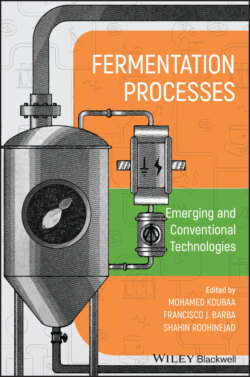Fermentation Processes: Emerging and Conventional Technologies

Реклама. ООО «ЛитРес», ИНН: 7719571260.
Оглавление
Группа авторов. Fermentation Processes: Emerging and Conventional Technologies
Table of Contents
List of Tables
List of Illustrations
Guide
Pages
Fermentation Processes. Emerging and Conventional Technologies
About the Editors
List of Contributors
Preface
1 Introduction to Conventional Fermentation Processes
1.1 Bioprocesses
1.1.1 Production of Microbial Biomass
1.1.2 Production of Microbial Metabolites
1.1.3 Production of Microbial Enzymes
1.1.4 Production of Recombinant Proteins
1.1.5 Production of Microbial Plasmids
1.1.6 Bioconversion
1.2 Energetic Metabolism
1.2.1 Energy Transfer and Redox Reactions
1.2.2 Aerobic Respiration
1.2.2.1 Glycolysis Pathway
1.2.2.2 Citric Acid Cycle
1.2.2.3 Electron Transport Chain and Oxidative Phosphorylation
1.2.3 Anaerobic Respiration
1.2.4 Fermentation
1.3 Microorganisms Used in Fermentation Processes
1.3.1 Bacteria
1.3.1.1 The Proteobacteria
1.3.1.2 The Gram‐Positive Eubacteria
1.3.2 Fungi
1.4 Fermentation Technology
1.5 Conclusions
References
2 Current Developments in Industrial Fermentation Processes
2.1 Introduction
2.2 Main Achievements in Industrial Fermentation
2.2.1 Fermentation Processes in Food Industry
2.2.1.1 Alcoholic Beverages
2.2.1.2 Enzymes
2.2.2 Fermentation Processes in Chemical Industry
2.2.2.1 Biofuels
2.2.2.2 Organic Acids
2.2.2.3 Triacylglycerols and Polyhydroxyalkanoates
2.2.2.4 Syngas Fermentation
2.2.3 Fermentation Processes in the Pharmaceutical Industry
2.2.3.1 Drugs
2.2.3.2 Recombinant Proteins
2.3 Current Developments in Industrial Fermentation
2.3.1 Microorganisms
2.3.2 Fermentation Media
2.3.2.1 Types of Media Sources
2.3.2.1.1 Carbon Sources
2.3.2.1.2 Nitrogen Sources
2.3.3 Fermentation Systems
2.3.3.1 Solid‐State Fermentation Bioreactors
2.3.3.1.1 Static Bioreactors
Fixed Bed Bioreactors
Perforated Trays Bioreactors
Fluidized‐Bed Bioreactors
2.3.3.1.2 Stirred Bioreactors
Koji Bioreactors
Horizontal Drum
Mixing Bioreactor
Rotating Drum
2.3.3.1.3 Recent Patents in Solid‐State Fermentation Bioreactors
2.3.3.2 Ultrasonic Fermentation Process
2.3.3.2.1 High‐Frequency Ultrasound in Fermentation
2.3.3.2.2 Low‐Frequency Ultrasound
2.3.3.3 Electrofermentation
2.3.4 Fermentation Optimization
2.3.5 Fermentation Process Modeling
2.3.5.1 Mechanistic Models
2.3.5.2 Computational fluid dynamics
2.3.6 Inhibition of Fermentation Processes
2.3.6.1 Substrate Inhibition
2.3.6.2 pH Inhibition
2.3.6.3 Inhibition by Undissociated Acids
2.3.6.4 Temperature Inhibition
2.3.6.5 Nitrogen Inhibition
2.3.6.6 Inhibition by Phosphate
2.3.6.7 Inhibition by Sulfide
2.3.6.8 Inhibition by Lactic Acid Bacteria
2.3.6.9 Inhibition by Metals
2.3.6.10 Inhibition by Phenolic and Furanic Mixtures
2.4 Conclusions
References
3 Culture Condition Changes for Enhancing Fermentation Processes
3.1 Introduction
3.2 Culture Media Used for Fermentation. 3.2.1 The Culture Media Purpose
3.2.2 Media Types
3.2.2.1 Synthetic Media
3.2.2.2 Semi‐synthetic Media
3.2.2.3 Complex Media
3.2.2.4 Defined Mineral Media
3.2.3 Culture Media: A Quantitative Approach
3.2.4 Culture Media: A Compositional Approach
3.2.4.1 Water
3.2.4.2 Energy Sources
3.2.4.3 Carbon Sources
3.2.4.4 Examples of Commonly Used Carbon Sources. 3.2.4.4.1 Carbohydrates
3.2.4.4.2 Glucose
3.2.4.4.3 Sucrose
3.2.4.4.4 Lactose
3.2.4.4.5 Oils and Fats
3.2.4.4.6 Hydrocarbons and Their Derivatives
3.2.4.4.7 Other Carbon Sources
3.2.4.5 Nitrogen Sources
3.2.4.5.1 Ammonia
3.2.4.5.2 Nitrogen‐Based Salts
3.2.4.5.3 Complex Nitrogen Sources
3.2.4.6 Minerals
3.2.4.7 Chelators
3.2.4.8 Growth Factors
3.2.4.9 Buffers
3.2.4.10 Precursors and Metabolic Regulators to Media
3.2.4.11 Precursors and Inhibitors
3.2.5 Impact of Culture Conditions on Fermentation Processes
3.2.5.1 The Temperature
3.2.5.2 The pH
3.2.5.3 The Cell Concentration
3.2.5.4 The Carbon Dioxide
3.2.5.5 The Ethanol
3.3 Metabolic Approaches
3.3.1 Pasteur Effect
3.3.2 Crabtree Effect
3.3.3 Custer Effect
3.3.4 Oxygen Requirements
3.3.5 Oxygen Function in Fermentation
3.4 Conclusions
References
4 Emerging Technologies and Their Mechanism of Action on Fermentation
4.1 Introduction
4.2 HHP Processing
4.3 Ultrasound
4.4 Pulsed Electric Fields
4.5 Microwaves
4.6 Conclusions
Acknowledgments
References
5 Biomass Fractionation Using Emerging Technologies
5.1 Introduction
5.2 Ultrasound Application for Biomass Fractionation
5.3 Microwave Application for Biomass Fractionation
5.4 PEF Application for Biomass Fractionation
5.5 Enzyme‐Assisted Fractionation of Biomass
5.6 SCF Fractionation of Biomass
5.7 Conclusions
References
6 Enhancing Microbial Growth Using Emerging Technologies
6.1 Introduction
6.2 Microbial Stimulation Using EFs
6.3 Stimulation Using US
6.4 Microbial Stimulation Using HP
6.5 Conclusions
Acknowledgments
References
7 Application of Fermentation to Recover High‐Added Value Compounds from Food By‐Products : Antifungals and Antioxidants
7.1 Introduction
7.2 Food Industry By‐Products and Global Estimates
7.3 Food By‐Products as Sources of Antifungals or Antioxidants
7.3.1 Fruit
7.3.2 Cereals
7.3.3 Dairy Products
7.3.4 Meat
7.3.5 Seafood
7.4 Fermentation as a Strategy for Food By‐Product Valorization
7.5 Recovery of High‐Added Value Compounds from Food By‐Products. 7.5.1 Plant‐Derived
7.5.2 Dairy Foods
7.5.3 Animal Foods
7.6 Technical and Economical Hurdles in Fermentation Assisted Recovery
7.7 Conclusions and Future Outlook
References
Index. a
b
c
d
e
f
g
h
i
j
k
l
m
n
o
p
q
r
s
t
u
v
w
y
WILEY END USER LICENSE AGREEMENT
Отрывок из книги
Edited by
Mohamed Koubaa
.....
During fermentation, all ATP is produced solely by glycolysis, which implies a much lower energy yield compared to aerobic respiration (2 mol of ATP against 38 in prokaryotes). Considering that glucose oxidation is partial, a large part of the energy originally contained in glucose remains stored in the chemical bonds of the final fermentation product (e.g. ethanol, lactic acid, etc.). Fermentation microorganisms must, therefore, compensate for this shortfall by the oxidation of a larger quantity of substrate.
Figure 1.4 Schematic representation of fermentation and energy generation.
.....